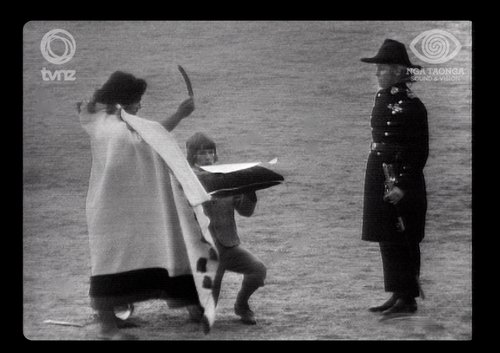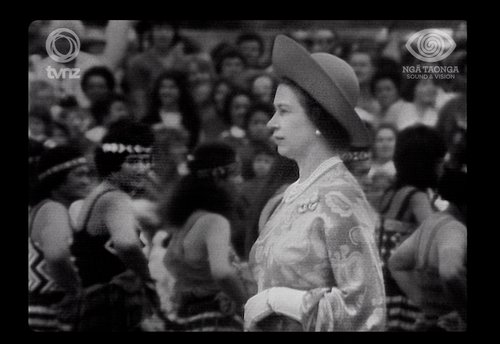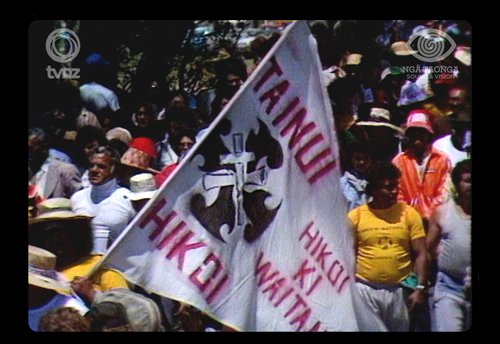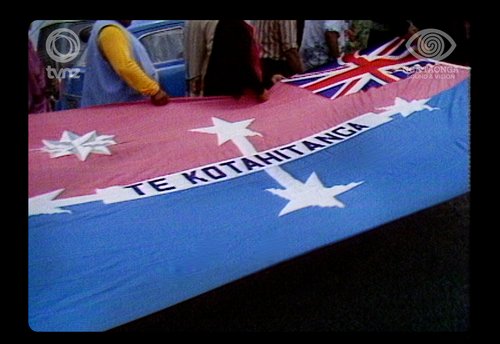
Hero image: Screengrab from From Pageant to Hīkoi, courtesy of Television New Zealand from material preserved and made available by Ngā Taonga Sound & Vision.
From Pageant to Hīkoi trailer
Every year, Ngā Taonga creates a Waitangi Day programme from our archive collection. With permission from kaitiaki and copyright holders, we provide copies to our culture and heritage partners, museums and libraries all over the country to play during the month of February*. This year’s programme, From Pageant to Hīkoi, presents two very different events at the Waitangi Treaty Grounds, contrasting two broadcasts made ten years apart.
In 1973, Waitangi Day was renamed New Zealand Day. The following year it was celebrated as a national public holiday for the first time (previously, Waitangi Day was a more local event). At the Treaty Grounds on 6 February 1974, New Zealand Day was kicked off with a televised two-and-a-half-hour “pageant of New Zealand” called Aotearoa.
Among the dignitaries present were Her Majesty Queen Elizabeth II, Prime Minister Norman Kirk, the Duke of Edinburgh and Prince Charles. Twenty thousand people in total were in the audience at the Treaty Grounds, with many more watching the telecast from home. We used clips of the telecast from the TVNZ collection to make up the first half of our programme.

The Queen at New Zealand Day, 1974
Courtesy of Television New Zealand from material preserved and made available by Ngā Taonga Sound & Vision.
If you are used to seeing quite sober Waitangi Day events at the Treaty Grounds, the New Zealand Day pageant of 1974 looks unusual. There were speeches and kapa haka as you’d expect, but a wide range of other acts performed too. Howard Morrison played Kupe in a dance that depicted Māori arriving in Aotearoa, followed by a long sequence of other nationalities. Songs and dances were performed by cultural groups from Britain, Western Europe, Dalmatia (present day Croatia), the Pacific Islands, India and more. There was a fierce demonstration of taiaha fighting, and a re-enactment of the signing of the Treaty. A band performed the song “Age of Aquarius” from the 1960s musical Hair. A giant moa laid an egg on the spot where the Treaty was signed, which apparently made the Queen laugh. It's a unique time capsule of New Zealand in the mid-1970s.
There were mixed feelings about New Zealand Day at the time. While many welcomed increased national awareness of the Treaty (and a new holiday), debate continued over what this day was for. Should it be about articulating a national identity, commemorating the signing of the Treaty, or something else? The focus on entertainment also seemed to ignore the longstanding tensions that existed between the Crown and its Treaty partners. The picture of multicultural harmony presented by the pageant was optimistic, but it hadn’t been achieved yet.

The hīkoi on Waitangi Day, 1984
Courtesy of Television New Zealand from material preserved and made available by Ngā Taonga Sound & Vision.
The 10 years that followed saw many watershed moments for Aotearoa. These included the Waitangi Day Act 1976, which reinstated the name ‘Waitangi Day’, establishment of the Waitangi Tribunal, the Māori Land Marches, and the occupations of Takaparawhau (Bastion Point) and Tainui Awhiro ki te pūaha o Whāingaroa - The Kokiri Centre (Raglan).
By Waitangi Day 1984, a more sombre mood prevailed. A peaceful hīkoi departed from Ngāruawāhia for Waitangi expecting to meet with Governor-General Sir David Beattie, who would receive their submissions on the Treaty. But while the Governor-General waited, the hīkoi was stopped by police, who would only allow part of the group onto the Treaty Grounds. The Kotahitanga hīkoi, led by Eva Rickard, refused to split up, and a long delay ensued. Intermediaries were not able to resolve the impasse and the meeting fell through. This event is recounted in an episode of Koha, which makes up the second half of From Pageant to Hīkoi.
*If you work for a library, museum or other culture and heritage organisation, and would like to show our programmes in future, please contact us.

Waitangi Day, 1984
Courtesy of Television New Zealand from material preserved and made available by Ngā Taonga Sound & Vision.
Mai i ngā pūranga whitiāhua o Aotearoa, koia nei te hōtaka ā Ngā Taonga Whitiāhua, e whakaaturia ana i ngā hirahira i tīpako mai i ētahi whitiāhua e rua, kātahi anō ka whakaukatia kia whakamamati, e hāngai ana ki te Rā o Waitangi nō roto mai i te kohikohinga rawa a Te Reo Tātaki o Aotearoa.I te tuaono o Pēpuere i te tau 1974, whakahaeretia ai te whakangahautanga Aotearoa i Te Papa Whenua o Waitangi. Ka rua me te haurua hāora te roa o te pāhōtanga mataora puta noa i Aotearoa. He pōwhiri nui whakaharahara i whakaritea mō Kuīni Irihāpiti te Tuarua me ngā manuhiri matararahi, nā wai rā ka tuwhera ake te ahurei, tōna 20,000 tāngata i tae atu.
E whai ana tēnei whitiāhua ukauka hou o Koha i te hīkoi mō Te Kotahitanga nā Tuaiwa (Eva) Rickard i ārahi. I heke whakateraro te hīkoi mai i Ngāruawāhia ki Te Papa Whenua o Te Tiriti o Waitangi ki reira tūtaki atu ki te māngai o te Kuīni, te Kāwana-Tianara a Tā David Beattie. Nā i whakaae ia ki te reo rāhiri i wharikihia e te rōpū Kotahitanga me ā rātou tuku tāpaetanga mō te Tiriti o Waitangi, auare ake.
Mai i ngā whakangahau o Aotearoa i te tau 1974, tae atu ki te hīkoi mō Te Kotahitanga i tēnei puni o Koha i te tau 1984, i roto i te whakaaturanga ka kite ko ngā takunetanga e rua, me te rereke rawa o ngā kaupapa i kawea atu ki Te Papa Whenua o Te Tiriti o Waitangi.
E tika ana kia mihia ngā Kaitiaki koutou i whakaae mai kia whakamahia e Ngā Taonga ēnei taonga puipuiaki, kia whakaaturia anō ngā rawa o roto, ngā whakapapa kōrero, me te hītori. He mea nui kia kite mai rā anō te iwi Māori me ngā uri whakaheke. Ki a koutou ngā ringa hāpai o Waitangi National Trust, me ngā uri taniwha o Waikato-Tainui Te Whakakitenga Incorporated kīhai i ārikarika ngā mihi.
Nō te hainatanga o Te Tiriti o Waitangi i te tau 1840, koia te rā i kōkiri ko ngā wai e rua tēnei te ramene ake nei. He tai kōhure te tai wāwā, he tai tīpoka te tai wīwī. Paripari ana ngā tai, he huamo, he auheke, he hureki, he tai timu, he tai pari. Ko ngā wai e rua te whakakotahi nei, eke, eke panuku, eke, eke Tangaroa. Aoinaake rā te āpōpō. Whiti ki te tika, whiti ki te ora, whiti ki te rangimārie titia iho.
Tīhei mauri ora.
Programme notes
Programme notes for From Pageant to Hīkoi
Download Waitangi Programme Notes 2024 FINAL – PDF, 118.7 KB